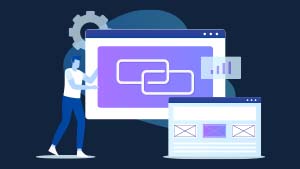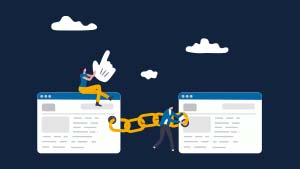Link-building is among the most important aspects of SEO and online growth in general. There’s quite a bit that goes into creating effective backlinks for your site that help boost your SEO and amplify your brand recognition. Link-building is a vast field of SEO; there are various techniques and link-building terms associated with the art of creating backlinks.
If you’re somewhat of a beginner in the link-building world, you might not be familiar with the various link-building terms that are used in the industry, and they may confuse you from time to time. So, let’s solve that, shall we?
This beginner’s guide to link-building definitions will help you understand the various factors associated with creating backlinks and further help you understand the importance of link-building!
Backlinks Glossary
An A to Z link-building terminologies list!
Anchor Text
Usually highlighted in a different colour or with a design element, anchor text is the text that contains the target link and redirects the user upon clicking it. Anchor text contains keywords that help make the link placement feel natural and engaging in order to tempt the user to click on it.
Algorithm Roll Out
Whenever Google updates its search engine algorithm, it means that Google has changed something in the way its algorithm operates. It is necessary to ensure that these changes are reflected in your SEO strategy to cope with the new update.
Authority
This might be among the most common terms you hear in the industry. Authority is among the three pillars of SEO, and it refers to the importance of a page in terms of a particular search query. So, when you hear the term high authority, it means that the page or website is particularly important regarding a specific search query.
Attributes
Although attribute isn’t particularly a link-building term, they still might be often used in the industry. Attributes refer to the different HTML elements of the webpage. For instance, image attribute (<img>), etc.
Backlinks
One of the most important terms and the focus of this article; backlinks are links redirecting users to your site. The goal is to place your site’s backlinks on high-traffic sites in order to amplify your customer reach, as well as your website’s authority.
Brand Mentions/Keywords
As the name suggests, brand mention is simply an online mention of your brand, either on social media, a blog site, or anywhere on the internet. In comparison, a brand keyword refers to a link to your website with your brand’s name as the anchor text.
Broken Links
Broken links are exactly what they sound like, links that no longer work or just return an error code like 404, 410 or even 503 when they’re clicked on.
Crawling
Crawling is something search engine bots, i.e. crawlers, do, which refers to the collection of information from all over the internet and storing it in a search index. When a user runs a search query, the search engine returns what’s stored in its search index, and for your site to show up on SERPs, your website has to be optimised for crawling.
Citation Flow
Citation flow is an SEO metric that is used to predict how ‘influential’ a URL might be depending upon the number of sites linked to it. Citation flow is sometimes abbreviated as CF too.
Canonicalisation
As weird as the name sounds, it’s actually pretty straightforward. Canonicalisation is the act of signalling the search engine that a specific URL refers to the original (master) copy of a web page by using something called a canonical tag in HTML. Canonicals are used to avoid SEO problems regarding duplicate content.
Citations
Citations are online mentions of your business. A citation includes your business’s NAP data, including the name, address, and phone number of your business.
Creating and updating citations can sometimes be a hectic task; why not get professionals like us to do it for you? Order our local citation services now!
Click-Through Rate
Click-through rate is essentially the ratio of the number of people who actually click on your site’s link as compared to the number of times your site’s link shows up somewhere.
Content
Although this is a pretty self-explanatory link-building terminology, content refers to the information on a web page. This may include text, images, videos, etc.
Deep Link
Deep links simply refer to the type of links that redirect a user to a specific page on your website other than the homepage.
Directories
A directory, as the name suggests, is a large collection of links to websites organised in various categories. Directories are also called local business directories.
Deindexed
Remember when we talked about search engine indexes? Well, getting deindexed means that your website is essentially kicked out of a search engine index and will no longer show up on the SERPs.
Disavow
Disavowing a link means that you’re signalling to Google that you no longer want a particular link credited to your site. This can be due to any number of reasons; one might believe that that link can’t be trusted and could prove to be harmful to their site.
Domain Authority
Similar to Authority, Domain Authority is a measure created by Moz that allows you to predict how likely a website will rank the SERPs.
Domain Rating
Domain Rating is another SEO metric that allows you to measure the quality and quantity of a particular website’s backlink profile.
Editorial Links
Links that are essentially provided to you without even asking for them are called editorial links. These are the most rewarding type of links as they don’t require any outreach or effort. A website gains editorial links based on its reputation.
External Links
External links are links that redirect a user to another domain. For instance, your website’s link placed on a reputable blog site is considered an external link.
Evergreen Content
Evergreen content is considered a sustainable type of content that doesn’t get outdated easily.
Followed Links
All links are essentially followed links unless they’re tagged with the ‘nofollow’ attribute. Followed links signal the search engine to credit these links in order to boost your SERP rankings.
Guest Posting
If your site isn’t reputable enough to score editorial links, or you just need to expand your online visibility as much as possible, you can reach out to high-traffic sites and write guest blogs for their website that link back to your site.
You need to have a team of expert content writers to write engaging guest posts. Luckily for you, our content writers have been writing world-class content for guest posts in all kinds of niches! Order our guest posting services to get winning and engaging content for your guest posts.
Google Analytics
Google provides a free analytics tool to monitor your site in terms of various metrics.
Href
Href is an HTML attribute for anchor tags. They contain the actual link of the anchor text.
Inbound Links
Inbound links are links that point to your site from an external site.
Infographics
Graphical representations of data to make understandable content are called infographics. Infographics are an important form of content that you can make for other websites in exchange for a link placement of your site.
Internal Links
As the name suggests, internal links are links that point to web pages within your website. Internal links are very important for crawling and, thus, important for SEO!
Keywords
Keywords are trending words or phrases that you can add to your content for search engines to pick up when a user runs a query related to that particular keyword.
Link-Building
Link-building is a white-hat SEO technique that involves getting your site’s link placed in high-ranking websites or acquiring links from other websites to build a strong backlink profile for your website.
Link Reclamation
Remember when we talked about broken links? Well, the process of finding and replacing broken links to your website is called link reclamation.
Mobile-First Indexing
Mobile-first indexing is Google’s new methodology of indexing websites; the bots first crawl the mobile version of your website and then the desktop one.
Nofollow Links
Links that you specifically signal the search engine not to follow using the ‘nofollow’ attribute are called nofollow links.
Off-Page SEO
SEO techniques, like link-building, that are implemented to improve the SEO performance of a website and don’t require you to work directly on the website, are called off-page SEO techniques.
On-Page SEO
On-page SEO involves SEO enhancement techniques that require you to work directly on the website, like keyword integration, etc.
Outreach
Reaching out to websites to build links with you is called performing outreach. It is often termed blogger outreach because most sites reach out to bloggers to make guest posts and build links.
Most businesses get experienced professionals to perform outreach on their behalf, like OutreachGirls! We have been in the outreach industry for years, and we are experienced in launching successful blogger outreach campaigns for businesses of all kinds. You can order our blogger outreach services here.
Page Authority
Page authority is another SEO metric from Moz that allows you to predict how well a particular web page will score on SERPs.
Page Rank
PageRank is essentially an algorithm used by Google to determine how important a particular website is. There are a number of factors that this algorithm focuses on before judging a website, mainly the quality and quantity of the links to that page.
Paid Links
Backlinks that are bought for money are called paid links. Paid links are a violation of Google’s guidelines.
PBNs
PBNs, or private blog networks, are networks of websites that you can instantly get links from to bump your rankings. PBNs are considered a black-hat SEO technique and are frowned upon in the community.
Query
When a user searches for something, they’re running a query on the search engine.
SERPs
SERP stands for search engine results page. SERPs are what a search engine returns to the user when they run a search query.
Spam Links
Spam links refer to links that are completely out of context and seem forced. Spam links damage a site’s reputation and could get you in serious trouble in the eyes of Google’s guidelines.
Sitemap
Sitemap is essentially a map for search engines to guide them on how to crawl your website’s pages.
Trust Flow
Trust flow is a metric that measures how important or influential a URL is based on the quality as well as the authority of the websites that are linked to it. Trust flow, like citation flow, is often abbreviated as TF.
Unnatural Links
Unnatural links refer to links that are either spam, paid, or believed to be a part of a link scheme. These links are damaging to your website’s SEO and reputation.
URL Rating
URL rating is a measure of how strong the target site’s backlink profile is. URL rating is a score developed by Ahrefs.
So, this was every single link-building term that you should be familiar with! We hope that this link-building terminology guide has provided what you were looking for. Link-building can be a hectic and time-consuming task; most businesses get experienced professionals to do it for them. We have over 12 years of experience in building effective backlinks for businesses of all kinds! Get in touch with us now and grow your business to new heights.







